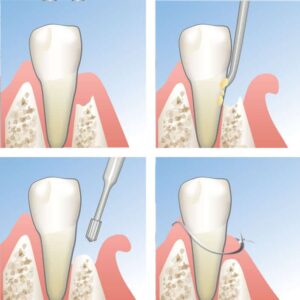Osseous Surgery: A Periodontal Pocket Reduction Procedure for Dental Deep Cleaning
What is osseous surgery?
Osseous surgery is also known as a periodontal pocket reduction procedure. Osseous surgery is one of the most common surgical techniques used in the treatment of advanced periodontal disease. In this procedure, the irregularity of the underlying bone is smoothened.
What are the Benefits of osseous surgery?
• Decreased pocket depth
• Better brushing of teeth as a toothbrush can access more areas
• More comfort in getting your teeth cleaned at a dental office
• Fresher breath
• Reduced bleeding of gums
• Healthier mouth
• Better brushing of teeth as a toothbrush can access more areas
• More comfort in getting your teeth cleaned at a dental office
• Fresher breath
• Reduced bleeding of gums
• Healthier mouth
What is done in osseous surgery?
The following steps are done in osseous surgery -
• You will receive a local anesthetic to numb your gums.
• Dr. Adatrow will make a slight incision (cut) around your chewing gum. After that, he will fold the gums back and kill the bacteria underneath. He would then smoothen any region where the bone is broken or irregularly shaped.
• If your bone is badly damaged, you might need bone graft and guided tissue regenerative membranes. These are called periodontal regeneration techniques.
• Your gums will be put back and covered with a periodontal dressing to help control your bleeding.
• You will receive a local anesthetic to numb your gums.
• Dr. Adatrow will make a slight incision (cut) around your chewing gum. After that, he will fold the gums back and kill the bacteria underneath. He would then smoothen any region where the bone is broken or irregularly shaped.
• If your bone is badly damaged, you might need bone graft and guided tissue regenerative membranes. These are called periodontal regeneration techniques.
• Your gums will be put back and covered with a periodontal dressing to help control your bleeding.
What is a bone graft?
Bone grafting is performed to replace lost bone in the jaw. If your upper jaw has no teeth or bones, a bone graft can stimulate the bone growth required to reshape the jaw and prepare it for dental implants.
How does Osseous Surgery work?
Far far away, behiIn the practice of ossification surgery, the sick root and bone are reached via a hollowed out tooth and the infected gums are removed. Bacteria and infected gums are also removed, which reduces pocketing. Additionally, periodontal health is improved. Both you and your dental professionals can more successfully and thoroughly eliminate plaque since the gum and jawbone are shaped to be highly adhereable to your teeth. by pushing the gum closer to the bone, the pockets are decreased or eliminated Tooth length and space between teeth are enhanced as a result. After osseous surgery, some people's temperature sensitivity may diminish. During the healing time, you may choose to use a toothpaste that is especially made for sensitive teeth. Because there is little gum tissue at the front of the mouth, various treatment methods may be considered, but they will be different depending on the extent of the teeth in the front of the mouth.

Why am I recommended osseous surgery?
You are recommended osseous surgery because you have pockets that are too extensive to clean with regular at-home oral hygiene and a professional treatment routine. Your bone and gum tissue should fit snugly around your teeth, forming a bacterium safety cover. So, to establish this safety cover, you have been recommended osseous surgery.
What medications can I take after osseous surgery?
Similar to any other surgery, you will experience some pain after osseous surgery. So, you will have to take some painkillers to manage the pain. You can have 400–600 mg of ibuprofen every 6–8 hours or as recommended by our dental team. Ibuprofen can help with pain relief and anti-inflammatory medication too. If you cannot take ibuprofen, 1–2 tablets of daily Tylenol ® should be taken every 4 hours or as recommended by our dental team. If required, Dr. Adatrow can prescribe a more potent painkiller like Vicodin and an antibiotic to control infection. Please contact us if you are having severe pain even after taking a painkiller or if you any other problems after the surgery.
Can osseous surgery be done under sedation?
Yes, sedation will help in easing your anxiety and helps us in treating you more effectively. However, you will have to communicate regarding your medical history with Dr. Adatrow. This will enable him to recommend the best sedation method for you.
When is it recommended to get osseous surgery?
In the event that the bone supporting your teeth has been destroyed, osseous surgery should be indicated. Scaling and root planing are often indicated in circumstances where nonsurgical treatment, such as that performed by a dentist, has failed to provide a result. The typical approach is known as osseous surgery and uses incision and ablation to remove infected gum tissue and damaged bone. Overall, the effect is a more healthy environment that slows down the growth of periodontal disease and enhances long-term maintenance.
Or it can be done on a single part of the mouth, or in total for all areas that are affected. One benefit of stretching the surgical treatment time for various regions of the mouth over a longer length of time is that doing so minimizes the occurrence of problems as a result of damage to underlying tissue. If the leaf coverage of a yard is reduced to one-fourth in the fall, this is like raking a quarter of a leaf-covered yard. When the wind blew the leaves away, your hard work would be undone. Treated spots in your mouth can re-infect previously untreated areas, just like untreated germs can return to an untreated location.



